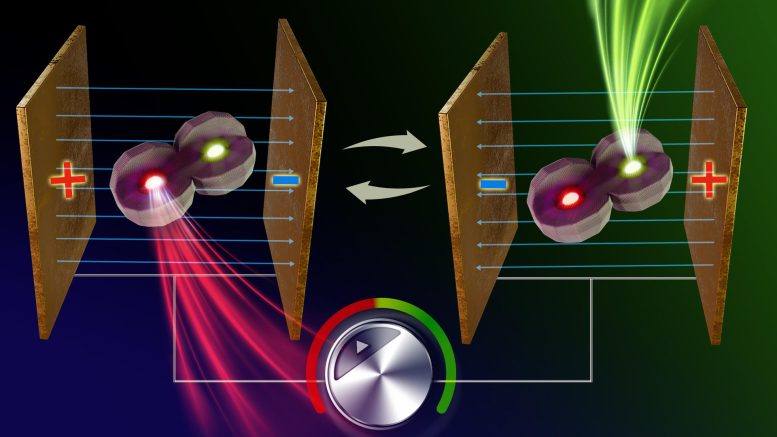
A nanoparticle made of two coupled quantum dots, each emitting light with distinct colors. applying an external voltage induces an electric field which can toggle the light emission from one side to the other, switching the emission color while keeping the overall light intensity. Credit: Artwork by Ehsan Faridi and Ehsan Keshavarzi – Inmywork Studio
Nanocrystals, despite their ability to be color-tuned and their utility in diverse technologies, have been restricted in their usage due to the need for distinct nanocrystals for each color and dynamic switching between colors has not been possible.
A team of Researchers at the Institute of Chemistry and The Center for Nanoscience and Nanotechnology at The Hebrew University of Jerusalem, including graduate student Yonatan Ossia with seven other members, and led by Prof. Uri Banin, have now come up with an innovative solution to this problem.

Yonatan Ossia, Hebrew University. Credit: Yoav Ossia
By developing a system of an “artificial molecule” made of two coupled semiconductor nanocrystals that emit light in two different colors, fast and instantaneous color switching was demonstrated.
Colored light and its tunability, are the basis to many essential modern-day technologies: from lighting, displays, fast optical fiber-communication networks, and more. Upon taking color-emitting semiconductors to the nanoscale (nano – one billionth of a meter, one hundred thousand times smaller than a human hair), an effect called quantum confinement comes into play: changing the size of the nanocrystal modifies the color of the emitted light. Thus, bright light sources can be obtained covering the entire visible spectrum.
Due to the unique color tunability of such nanocrystals, and their facile fabrication and manipulation using wet-chemistry, they are already widely used in high-quality commercial displays, giving them excellent color quality along with significant energy-saving characteristics. However, to this day, achieving different colors (such as needed for the different RGB pixels) required the use of different nanocrystals for each specific color, and dynamical switching between the different colors was not possible.
Although color tuning of single colloidal nanocrystals which behave as “Artificial atoms” has been previously investigated and implemented in prototype optoelectronic devices, changing colors actively has been challenging due to the diminished brightness inherently accompanying the effect, which only yielded a slight shift of the color.

Prof. Uri Banin, Hebrew University. Credit: Nati Shohat, Flash 90
The research team overcame this limitation, by creating a novel molecule with two emission centers, where an electric field can tune the relative emission from each center, changing the color, yet, without losing brightness. The artificial molecule can be made such that one of its constituent nanocrystals is tuned to emit “green” light, while the other “red” light.
The emission of this new dual color emitting artificial molecule is sensitive to external voltage inducing an electric field: one polarity of the field induces emission of light from the “red” center, and switching the field to the other polarity, the color emission is switched instantaneously to “green”, and vice versa. This color-switching phenomenon is reversible and immediate, as it does not include any structural motion of the molecule. This allows one to obtain each of the two colors, or any combination of them, simply by applying the appropriate voltage on the device.
This ability to precisely control color tuning in optoelectronic devices while preserving intensity, unlocks new possibilities in various fields including in displays, lighting, and nanoscale optoelectronic devices with adjustable colors, and also as a tool for sensitive field sensing for biological applications and neuroscience to follow the brain activity. Moreover, it allows to actively tune emission colors in single photon sources which are important for future quantum communication technologies.
Prof. Uri Banin from the Hebrew University of Jerusalem explained, “Our research is a big leap forward in nanomaterials for optoelectronics. This is an important step in our exposition of the idea of “nanocrystal chemistry” launched just a few years ago in our research group, where the nanocrystals are building blocks of artificial molecules with exciting new functionalities. Being able to switch colors so quickly and efficiently on the nanoscale as we have achieved has enormous possibilities. It could revolutionize advanced displays and create color-switchable single photon sources.”
By utilizing such quantum dot molecules with two emission centers, several specific colors of light using the same nanostructure can be generated. This breakthrough opens doors to developing sensitive technologies for detecting and measuring electric fields. It also enables new display designs where each pixel can be individually controlled to produce different colors, simplifying the standard RGB display design to a smaller basis of pixels, which has the potential to increase the resolution and energy savings of future commercial displays.
This advancement in electric field-induced color switching has immense potential for transforming device customization and field sensing, paving the way for exciting future innovations.
Reference: “Electric-field-induced colour switching in colloidal quantum dot molecules at room temperature” by Yonatan Ossia, Adar Levi, Yossef E. Panfil, Somnath Koley, Einav Scharf, Nadav Chefetz, Sergei Remennik, Atzmon Vakahi and Uri Banin, 3 August 2023, Nature Materials.
DOI: 10.1038/s41563-023-01606-0
The study was funded by the European Research Council.

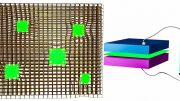
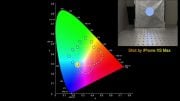
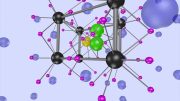
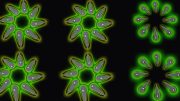
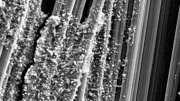
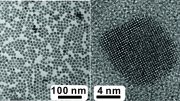


Be the first to comment on "Unleashing a New Era of Color-Tunable Nano-Devices – The Smallest Ever Light Source With Switchable Colors"